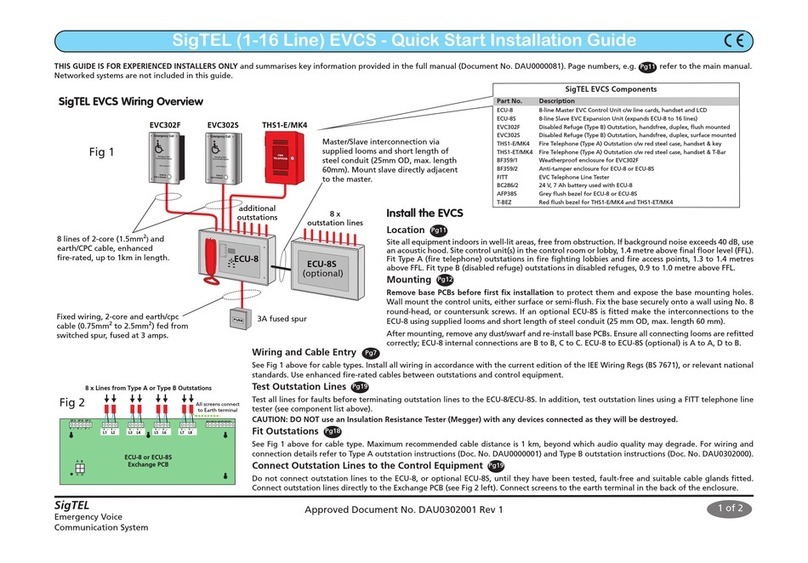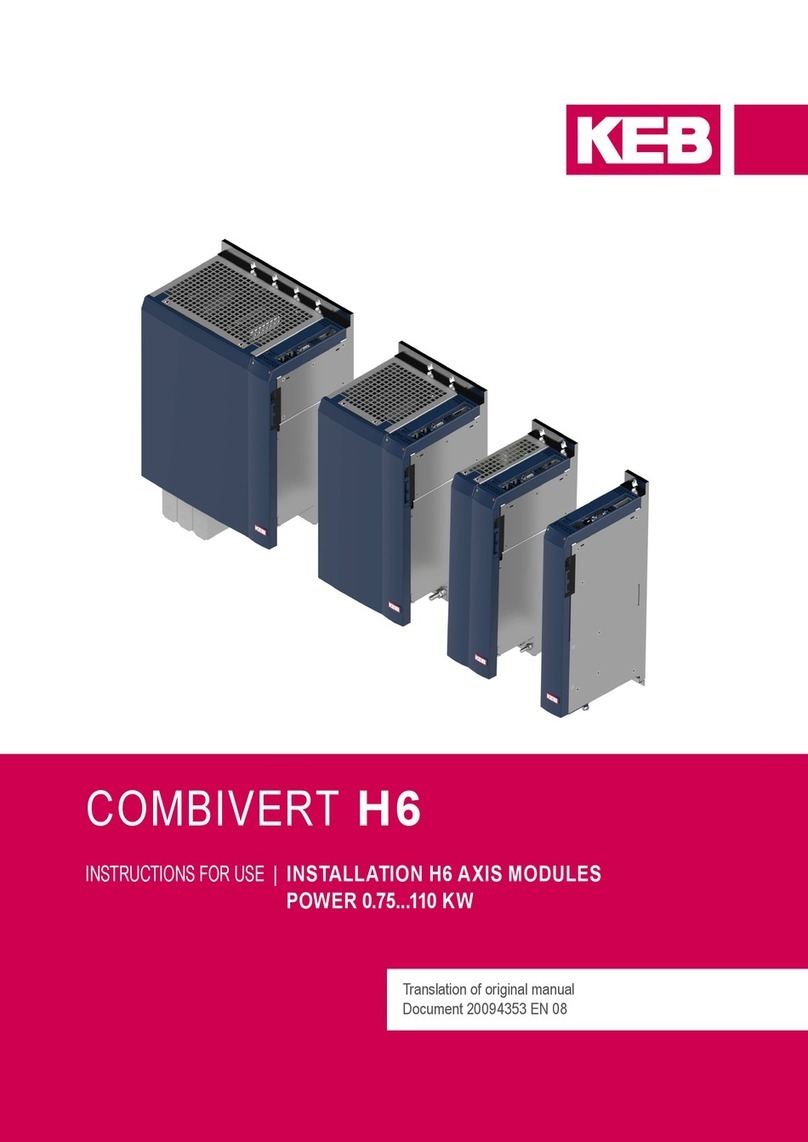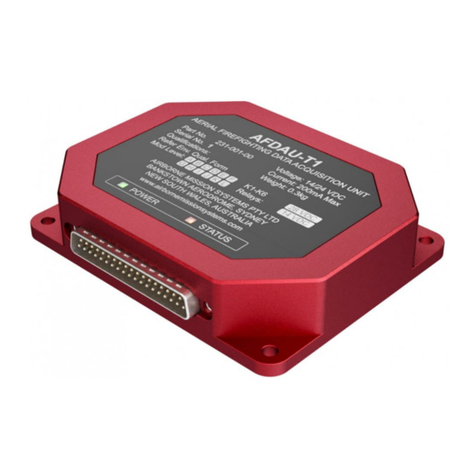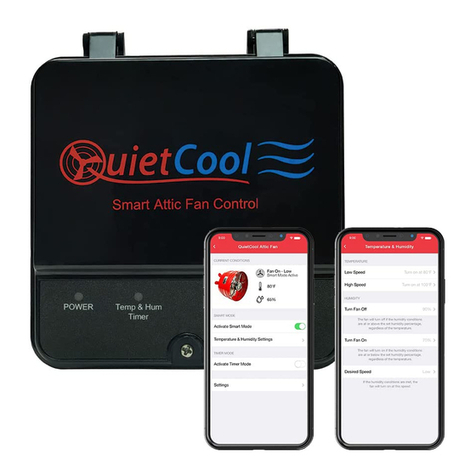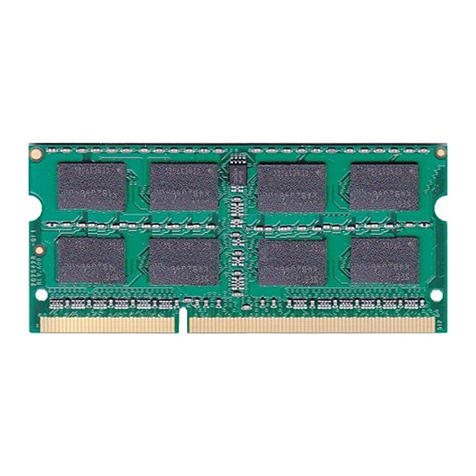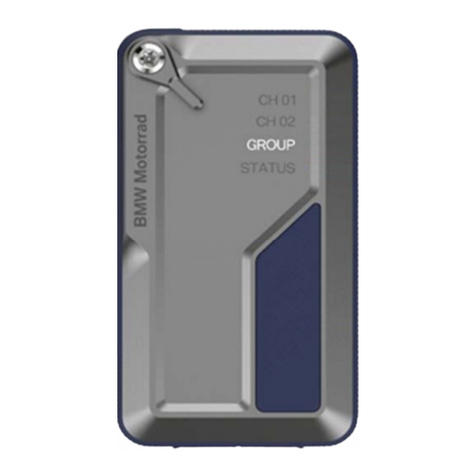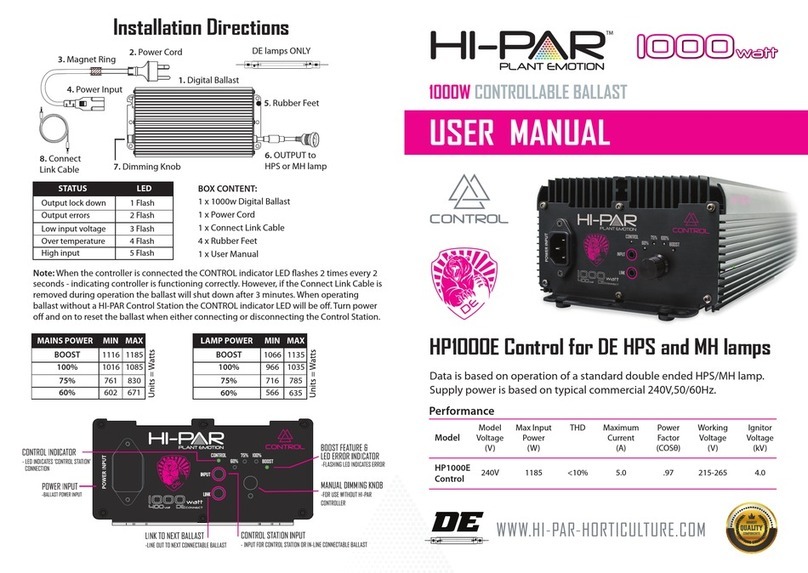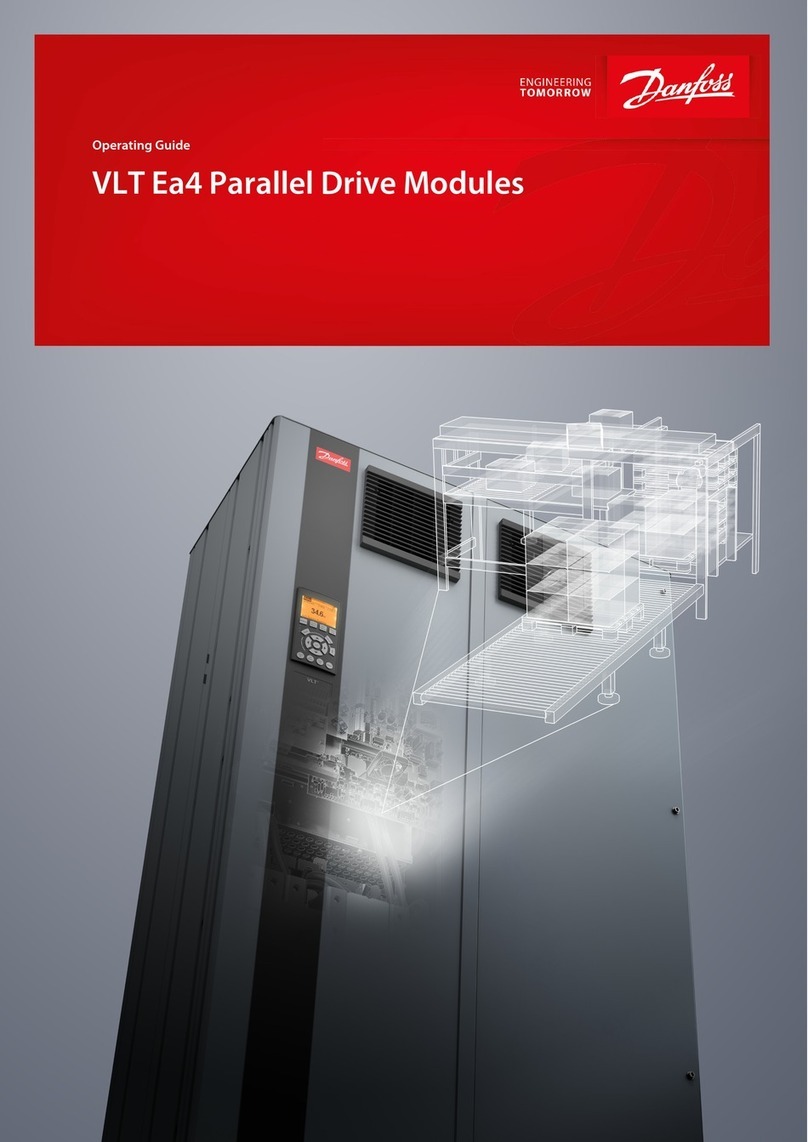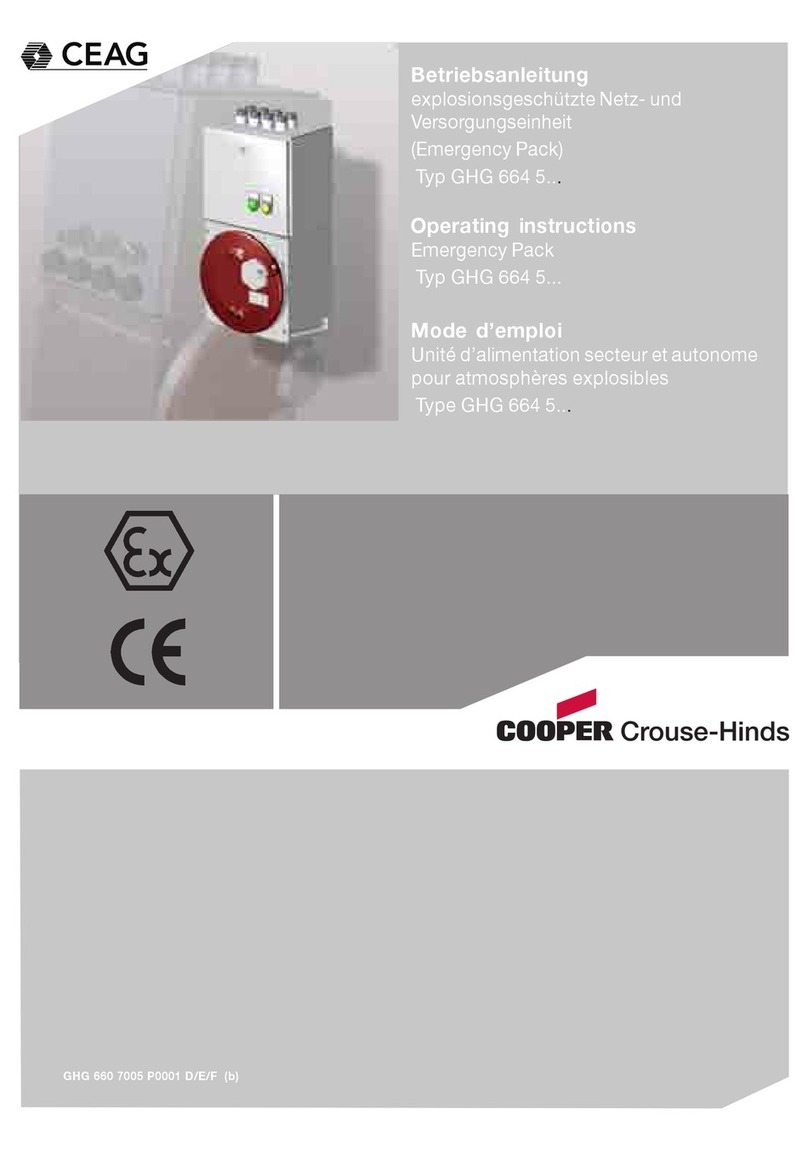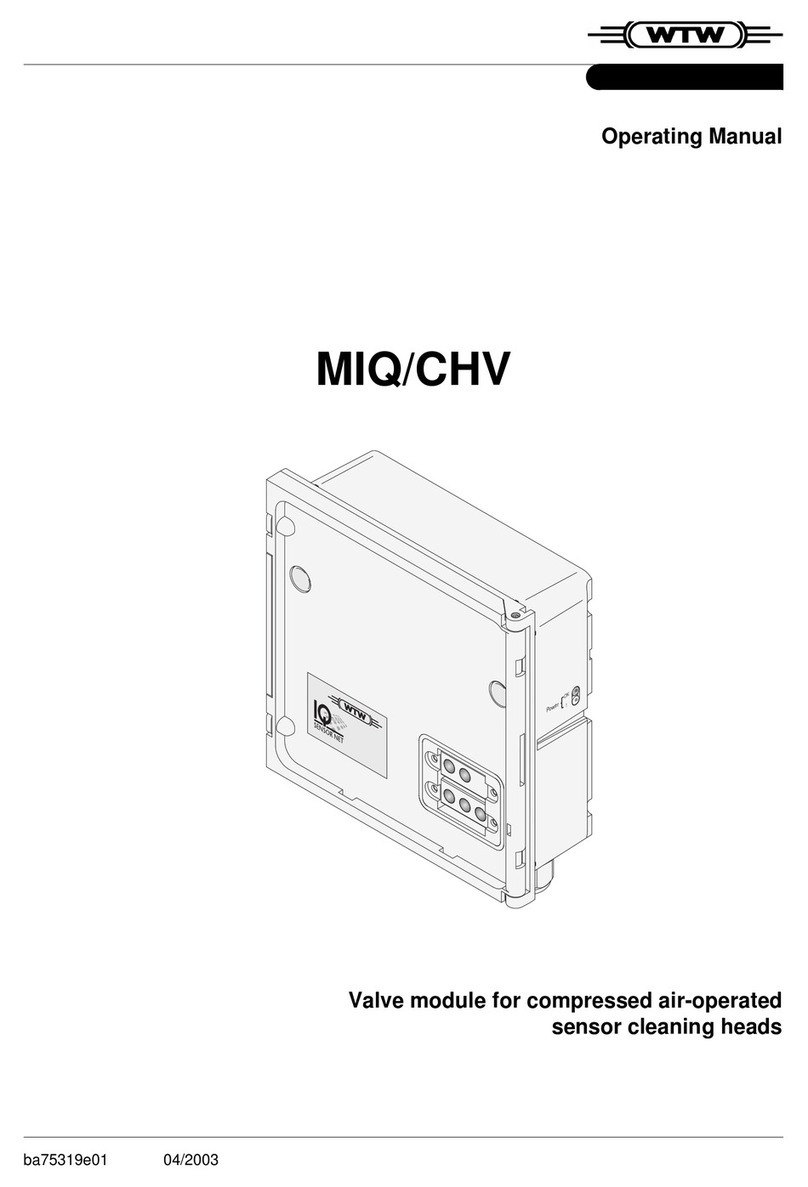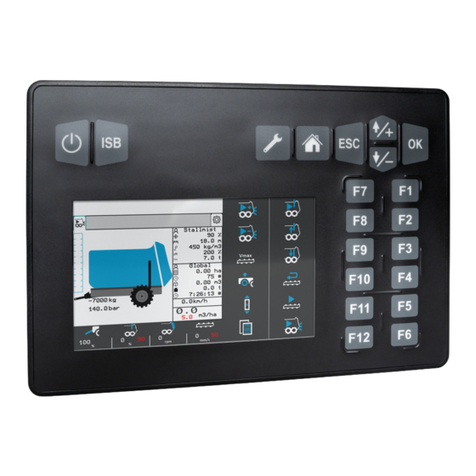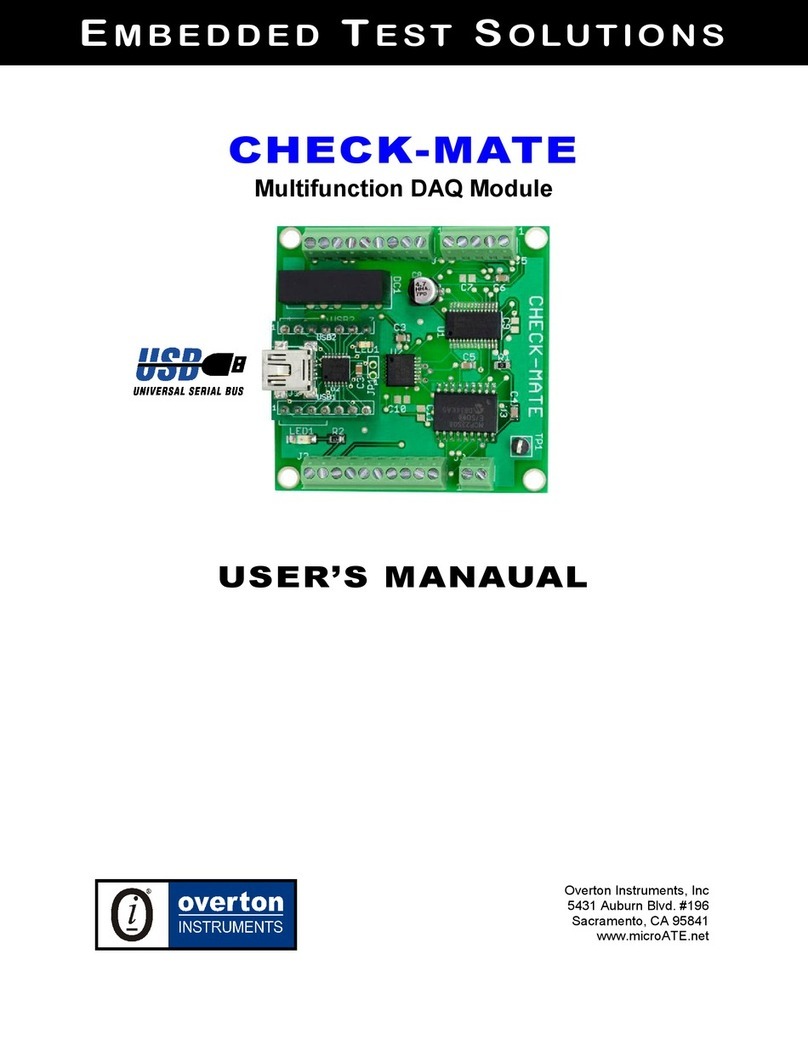SigTEL Compact ECU-4 Manual

SigTEL Compact
Emergency Voice
Communication
System (EVCS)
Installation and
Configuration
Manual
Approved Document No. DAU0000091 Rev 6
Wall Control Unit
(with handset)
Wall Control Unit
(no handset)
Desk Control Unit
(with handset)

SigTEL Compact Installation and Configuration Manual
SigTEL Approved Document No. DAU0000091 Rev 6 Page 2 of 36
Emergency Voice
Communication System
AN EXPLANTION OF TERMS AND DEFINITIONS USED IN THESE INSTRUCTIONS IS LISTED IN SECTION 22.
Contents
1IMPORTANT NOTES......................................................................................................................................................4
2REGULATIONS AFFECTING EVCS ...................................................................................................................................4
3SIGTEL COMPACT COMPONENTS .................................................................................................................................5
3.1 MCU WALL UNIT (PART NOS.ECU-4, ECU-8, ECU-16) .....................................................................................................5
3.2 LCU WALL UNIT (PART NO.ECU-8NT) .............................................................................................................................5
3.3 GREY FLUSH BEZEL (PART NO.EVC385) .............................................................................................................................5
3.4 DESK CONTROL UNIT (PART NO.ECU-224).........................................................................................................................5
3.5 TYPE AFIRE TELEPHONE OUTSTATION (PART NOS.EVC301RPO, EVC301RLK).......................................................................5
3.6 FLUSH-MOUNTING BEZEL (PART NO.T-BEZ301)..................................................................................................................5
3.7 TYPE BDISABLED REFUGE OUTSTATION -SURFACE MOUNTED (PART NO.EVC302S/GS) ............................................................6
3.8 TYPE BDISABLED REFUGE OUTSTATION -FLUSH MOUNTED (PART NO.EVC302F/GF)................................................................6
3.9 TYPE BOUTSTATION ENCLOSURE (PART NO.BF359/1) .........................................................................................................6
3.10 ENCLOSURES (PART NO.BF359/3M, BF359/3S)...............................................................................................................6
3.11 DISABLED PERSONS TOILET ALARM (PART NO.NC951)..........................................................................................................6
3.12 NETWORK COMMS CARD (PART NO.ECU722/ECU723) ......................................................................................................6
3.12.1 Key features of the EVCS networked system: ..............................................................................................7
4CABLES .........................................................................................................................................................................7
5TYPICAL SYSTEMS.........................................................................................................................................................8
5.1 SYSTEM UP TO 4OR 8EXTENSIONS ....................................................................................................................................8
5.2 SYSTEM UP TO 16 EXTENSIONS..........................................................................................................................................8
5.3 NETWORKED SYSTEM UP TO 224 EXTENSIONS,I.E.THE MAXIMUM NUMBER OF EXTENSIONS .........................................................9
5.4 NETWORKED SYSTEM BLOCK DIAGRAM..............................................................................................................................10
6FIRST FIX INSTALLATION.............................................................................................................................................11
6.1 EQUIPMENT LOCATION ..................................................................................................................................................11
7MOUNTING WALL UNITS............................................................................................................................................12
7.1 REMOVE THE BASE PCBS...............................................................................................................................................12
7.2 REMOVE THE LID ..........................................................................................................................................................12
7.3 REMOVE KNOCKOUTS &CUT GLAND HOLES .......................................................................................................................12
7.4 FIX THE BASE TO THE WALL .............................................................................................................................................12
7.5 RE-INSTALL THE BASE PCBS............................................................................................................................................13
8INSTALLING THE ECU722/ECU723 NETWORK COMMS CARD (OPTIONAL) ..................................................................14
9NETWORK CONNECTIONS (OPTIONAL).......................................................................................................................15
10 MAINS WIRING ..........................................................................................................................................................16
11 FITTING OUTSTATIONS & DPTA INTERFACE................................................................................................................17
11.1 CABLES.......................................................................................................................................................................17
11.2 LOCATION...................................................................................................................................................................17
11.3 FITTING TYPE AOUTSTATION (EVC301RPO/EVC301RLK) ................................................................................................17
11.4 FITTING TYPE BOUTSTATION (EVC302S/GS AND EVC302F/GF) ........................................................................................17
11.5 WIRING TO A DISABLED PERSONS TOILET ALARM (DPTA) .....................................................................................................17
12 TESTING EXTENSIONS.................................................................................................................................................18
12.1 INSULATION RESISTANCE TESTING.....................................................................................................................................18
12.2 THE FITT LINE TESTER....................................................................................................................................................18

SigTEL Compact Installation and Configuration Manual
SigTEL Approved Document No. DAU0000091 Rev 6 Page 3 of 36
Emergency Voice
Communication System
13 SECOND FIX INSTALLATION ........................................................................................................................................18
13.1 CONNECTING EXTENSIONS TO THE MCU/LCU WALL UNIT ....................................................................................................18
13.2 FAULT MONITORING......................................................................................................................................................18
13.3 MCU/LCU WALL UNIT INPUT CONNECTIONS (DISABLING THE SYSTEM) ...................................................................................19
13.4 MCU/LCU WALL UNIT OUTPUT CONNECTIONS ..................................................................................................................19
13.5 MCU WALL UNIT TO ECU-224 DESK CONTROL UNIT ........................................................................................................20
14 INDICATORS & CONTROLS..........................................................................................................................................21
14.1 MCU WALL UNIT EXTERNAL INDICATORS...........................................................................................................................21
14.2 MCU WALL UNIT DISPLAY ..............................................................................................................................................21
14.3 EXTERNAL CONTROLS ....................................................................................................................................................22
14.4 INTERNAL CONTROLS.....................................................................................................................................................22
15 FAULT MESSAGES.......................................................................................................................................................22
16 POWERING UP AND TESTING .....................................................................................................................................23
17 AUTOMATIC CONFIGURATION ...................................................................................................................................25
17.1 SINGLE,NON-NETWORKED SYSTEM CONFIGURATION ...........................................................................................................25
17.2 NETWORKED SYSTEM CONFIGURATION .............................................................................................................................26
17.3 ADDING OR REPLACING WALL UNITS,OUTSTATIONS OR DPTA AFTER COMMISSIONING...............................................................28
17.4 DEFAULT NAMES ..........................................................................................................................................................28
17.5 NAMING EXTENSIONS....................................................................................................................................................28
17.5.1 Interactive naming ....................................................................................................................................29
17.5.2 Manual naming .........................................................................................................................................29
17.5.3 EVC Configurator .......................................................................................................................................29
18 ADDITIONAL ENGINEER FUNCTIONS...........................................................................................................................30
18.1 CHANGE THE SECURITY PIN CODE ....................................................................................................................................30
18.2 HARMONISE NAMES (NETWORKED SYSTEM ONLY)...............................................................................................................30
18.3 LATCH FAULTS..............................................................................................................................................................31
18.4 CLEAR RECENT CALLS .....................................................................................................................................................31
18.5 AUTO-ANSWER ............................................................................................................................................................31
18.6 MAKING WALL UNITS RING INSTEAD OF BUZZ WHEN OUTSTATIONS ARE CALLING IN....................................................................32
18.7 FIRST COME,FIRST SERVE ...............................................................................................................................................32
18.8 CLEAN START PROCEDURES.............................................................................................................................................32
19 COMPONENT SPECIFICATIONS ...................................................................................................................................33
20 ENHANCED SIGTEL COMPACT FEATURES....................................................................................................................34
20.1 FIRMWARE VERSION AND WALL/DESK UNIT NAME...............................................................................................................34
21 INSTALLATION AND COMMISSIONING CERTIFICATE...................................................................................................35
22 TERMS AND DEFINITIONS...........................................................................................................................................36

SigTEL Compact Installation and Configuration Manual
SigTEL Approved Document No. DAU0000091 Rev 6 Page 4 of 36
Emergency Voice
Communication System
1 Important Notes
READ THIS SECTION BEFORE INSTALLING/MAINTAINING THIS PRODUCT
CAUTION
This equipment must only be installed and maintained by a suitably skilled and technically competent
person. No responsibility can be accepted by the manufacturer, or distributors of this product for any
misinterpretation of an instruction, or guidance note, or for the compliance of the system as a whole.
About this guide
This guide explains how to install, commission and maintain a SigTEL EVCS disabled refuge and fire telephone
system. A separate user manual (ref. DAU0000092) includes detailed operational information, some of which will
need to be referred to by the installation engineer when setting up the system.
No responsibility can be accepted by the manufacturer, or distributors for any misinterpretation of these instructions,
or for the compliance of the system as a whole.
This installation guide must not be accessible to the user.
System design
EVCS design is beyond the scope of this document. An understanding of system components and their use is
assumed.
We recommend that you read the latest edition of BS 5839 Part 9 (available from the BSI, http://www.bsigroup.com,
for this information. Contact the building control, or fire officer in case he has any special requirements.
Equipment guarantee
This equipment is not guaranteed unless the system is installed and commissioned in accordance with national
standards by an approved and competent person, or organisation.
General precautions
Do not test wiring with an insulation tester (Megger) with any equipment connected as the 500 volt test will destroy
these devices totally. You must observe local wiring regulations.
Do not run SELV and LV cables in the same enclosure without adequate insulation between them.
SigTEL EVCS control equipment is designed to be installed indoors. Outstations are not IP rated so should not be
installed outdoors unless an IP65, or better housing, is used and cables are installed so as to prevent the ingress of
moisture.
Anti-static handling guidelines
Make sure that electro-static handling precautions are taken immediately before handling PCBs and
other static sensitive components. Before handling any static-sensitive items, Operators should get
rid of any electrostatic charge by touching a sound safety earth.
Always handle PCBs by their sides and avoid touching any components. PCBs should be stored in
a clean, dry place that is free from vibration, dust and excessive heat. Storing the PCBs in a suitable
cardboard box will also guard them against mechanical damage.
2 Regulations Affecting EVCS
Disabled refuge systems are called for by DETR Approved document B (Fire safety) volume 2, section 4, Design for
vertical escape and BS 5588 Fire precautions in the design, construction and use of buildings, Part 8, Code of
practice for means of escape for disabled people.
Fire telephone systems for buildings are called for by BS 5588 Fire precautions in the design, construction and use
of buildings Part 5, Code of practice for firefighting stairs and lifts, Part 10, Code of practice for shopping complexes
and Part 11, Code of practice for shops, offices, industrial, storage and other similar buildings.
Fire telephone systems for sports venues are called for by the Guide to safety at sports grounds.
The installation of EVCS’s is covered by BS 5839-9 Fire detection and fire alarm systems for buildings –Part 9:
Code of practice for the design, installation, commissioning and maintenance of emergency voice communication
systems.

SigTEL Compact Installation and Configuration Manual
SigTEL Approved Document No. DAU0000091 Rev 6 Page 5 of 36
Emergency Voice
Communication System
3 SigTEL Compact Components
Note: See Specification (section 19) for component details.
3.1 MCU wall unit (part nos. ECU-4, ECU-8, ECU-16)
The master control unit (MCU) controls the EVCS and allows the Operator to
communicate with the outstations.
Each MCU is wall mounted and has either four extensions (ECU-4), eight
extensions (ECU-8), or 16 extensions (ECU-16).
One extension typically has one outstation (Type A or B) or a disabled persons
toilet alarm (DPTA) connected.
A flush bezel (EVC385) and an anti-tamper enclosure (BF359/3M) are available
to house the unit.
Note: Up to 14 MCU and LCU wall units can be connected on a network by
installing a Network Comms Card in each unit.
3.2 LCU wall unit (part no. ECU-8NT)
The line control unit (LCU) is identical to an MCU but it does not have a handset
mounted on its front. Each LCU has eight extensions.
3.3 Grey flush bezel (part no. EVC385)
This flush mounting bezel is used with the MCU/LCU and provides a neat finish when an enclosure is semi-recessed
(up to 60 mm).
3.4 Desk control unit (part no. ECU-224)
This 1-224 line unit is used during normal operation of the system, to answer
or make calls to outstations. It has a handset and a display.
Note: The ECU-244 unit connects to a Network Communications Card
(ECU723) fitted inside an MCU wall unit, i.e. one ECU-224 per ECU723 per
MCU. Therefore, a maximum of 14 ECU-224’s can be installed on a network.
The ECU-224 is intended to be free-standing. However, a sloping wall
mounting shelf (ECUWMB) is available.
3.5 Type A fire telephone outstation (part nos. EVC301RPO, EVC301RLK)
One Type A outstation is connected to one extension so that the control room can call out to
specific locations and also know which location is calling in.
The outstation consists of a telephone-style handset housed within a wall-mounted, red steel
case. Two versions are available a magnetic ‘push to open’ version (EVC301RPO) right, and
a ‘lift lock’ version (EVC301RLK) used to prevent unauthorised access.
Both units can be surface mounted, or a flush mounting bezel (T-BEZ301) is available.
3.6 Flush-mounting bezel (part no. T-BEZ301)
This red flush bezel provides a neat finish when a Type A fire telephone is semi-recessed.

SigTEL Compact Installation and Configuration Manual
SigTEL Approved Document No. DAU0000091 Rev 6 Page 6 of 36
Emergency Voice
Communication System
3.7 Type B disabled refuge outstation - surface mounted (part no. EVC302S/GS)
One Type B outstation is connected to one extension so that the control room can call out to
specific locations and also know which location is calling in. The EVC302S has a stainless
steel fascia and the EVC302GS has a green mild steel fascia. Both units use hands-free,
duplex operation and have a ‘Push to Call or Answer’button, Call in Progress LED, buzzer
and apertures for a microphone and loudspeaker.
3.8 Type B disabled refuge outstation - flush mounted (part no. EVC302F/GF)
Identical to the EVC302S/GS version but with a flat fascia suitable for flush installation. The
EVC302F has a stainless steel fascia and the EVC302GF has a green mild steel fascia. An
IP66 rated housing (BF359/1) is available to allow the outstation to be used outdoors.
3.9 Type B outstation enclosure (part no. BF359/1)
This weatherproof enclosure is used to protect an EVC302F/GF Type B outstation when used
at an external disabled refuge. It is supplied with a non-locking handle (as disabled refuge
points should not normally be locked) and has an IP66 rating.
3.10 Enclosures (part no. BF359/3M, BF359/3S)
The BF359/3M is a stainless steel, anti-tamper enclosure used to house an MCU wall
unit. It is supplied with two optional locking kits; BF359/3CL (camlock kit) or BF359/3SL
(solenoid kit).
The BF359/3S is a shallower variant and is used to house an LCU wall unit.
3.11 Disabled persons toilet alarm (part no. NC951)
The EVCS is able to interface to a disabled persons toilet alarm (DPTA) system. This is a
secondary function to the primary purpose of the EVCS. If the site has toilet alarms AND
they are connected into the EVCS, then active toilet alarms will be displayed at the wall unit
and desk units. As toilet alarm monitoring is a secondary function, any activated toilet alarms
will be suppressed from being displayed if there are any calls from/to any outstations. At the
end of outstation calls the activated toilet alarms will then be displayed.
3.12 Network comms card (part no. ECU722/ECU723)
The ECU722 Network Comms Card enables up to 14 MCUs or LCU wall units to be
connected on a network. The ECU723 Network Comms Card enables up to 14 MCUs
or LCUs plus up to 14 ECU-224 desk control units to be connected on a network. Note
that if an ECU-224 is fitted with no network, then an ECU723 is still required. See
section 5.4 for further details.
The ECU722 and ECU723 cards are fitted inside the MCU/LCU and transmit both
speech audio and digital data.
ECU723 shown

SigTEL Compact Installation and Configuration Manual
SigTEL Approved Document No. DAU0000091 Rev 6 Page 7 of 36
Emergency Voice
Communication System
3.12.1 Key features of the EVCS networked system:
1. Allows the interconnection of up to 14 wall and 14 desk control unitsusing 4 x 2-core, 1.5 mm2, fire-rated wiring.
2. Maximum length on the speech wiring loop, or digital linear wiring = 1 km.
3. Wall and desk control units monitors both the network wiring and each other for faults (open and short circuits).
4. Fault tolerant network that allows the system to continue working in the event of a single cable break in the
speech or digital wiring.
5. Each networked unit can be programmed with the following configuration:
One MCU wall unit is configured as the ‘master’and has control over the system. The other control units
(MCU/LCU/ECU-224)actasrepeatersbutcantakecontrolfromthecurrentmasterwhenasecurityPINcodeisentered,
either at the master or a repeater. PIN code entry is not required in ‘first come, first served mode’ (see section 18.7).
The current master displays the location of calls and the description of faults on the EVCS. Faults on current repeater
units are displayed at the master as remote faults.
Calls from any outstation, regardless of which unit they are connected to, are automatically routed to the current
master unit. Current repeater units indicate that outstations are calling the master unit and can take control of the
system by picking up their handsets and entering a security PIN code.
When no outstations are calling in, ability to take control from the current master unit at any repeater unit (by entering
a security PIN code). For example, the nearest unit to the building entry point. Also, able to give control from the
current master unit to any repeater unit (by entering a security PIN code).
Changes made at the current master unit (e.g. security PIN codes, extension names, addition/removal of an
outstation) are automatically updated on all repeater units.
The current master unit is automatically dialled to by repeater units when their handsets are picked up (when no
outstations are calling in).
4 Cables
Generally, cables used between EVCS components, and for the low voltage Mains supply to the system, should be enhanced
fire-resistant [see 26.2e of BS 5839-1]. Please note the following exceptions.
BS 5839-9: section 14 the following recommendations are applicable:
c) Standard fire resisting cables [see 26.2d of BS 5839-1] should be considered to provide sufficient resistance to the effects of
fire with appropriate methods of support and jointing [see 26.2g of BS 5839-1] for:
1) EVC systems for use in disabled refuges but not for fire-fighting or similar purposes by, e.g. the fire and rescue service, in:
i) sprinklered buildings;
ii) unsprinklered buildings less than 30 m in height, provided that evacuation takes place in three or fewer phases.
2) Underground sections of cabling at sports and similar venues.
Interconnection
Cable Type
Extensions to outstations
2-core, 1.0 mm2or 1.5 mm2cable is recommended for each extension. Larger cables will stress
the connectors. The maximum cable resistance is 40 ohms, which is 1 km of 1.0 mm2. If this is
exceeded audio quality will degrade.
Extensions to DPTA
systems (NC951)
2-core cable is required for each extension.
Power supplies
The MCU/LCU wall unit requires fixed wiring using 2-core cable and earth/CPC cable (no less
than 0.75 mm2and no more than 2.5 mm2) fed from an isolating switched fused spur, fused at
3 amps. A plug and socket MUST NOT be used.
Networked systems
Either MCU to MCU, or
MCU to LCU
4 x 2-core, 1.5 mm2, up to 1 kmin length. This cable connects ECU722/ECU723 network comms
cards mounted inside the MCU/LCU wall unit.
Note: To provide full network reliability only 2-core cable should only be used. This allows two
separate cable paths to be runwith each path containing a single speech and data cable (which
should not be mixed in the same cable).
Networked systems
MCU/LCU to
ECU722/ECU723
Connects theMCU/LCU wall unit to the ECU722/ECU723 Network Comms Card using one CAT5
patch cable (supplied with ECU722/ECU723).
MCU to ECU-224
Two, 4-core 1.0 mm2or 1.5 mm2enhanced fire-rated cable up to 200 metres.
The ECU-224’s supplied 5 metre CAT5 lead should connect to an adjacent CAT5 socket with
mechanical protection in accordance with BS 5839-1.

SigTEL Compact Installation and Configuration Manual
SigTEL Approved Document No. DAU0000091 Rev 6 Page 8 of 36
Emergency Voice
Communication System
5 Typical Systems
5.1 System up to 4 or 8 extensions
Equipment required
One MCU wall unit (ECU-4) for 4 extensions, or one MCU wall unit (ECU-8) for 8
extensions (shown right), each MCU requires two 12 volt 7 Ah batteries
(BC286/2).
One optional Desk Control Unit (ECU-224) c/w CAT5 wall socket and back box.
One 3 A fused spur and back box per MCU.
One Type A Outstation (EVC301RPO/EVC301RLK), or one Type B Outstation
(EVC302F/GF/S/GS), or one DPTA (NC951) per extension.
One Telephone Line Tester (FiTT).
Interconnections
For each extension to outstation: up to 1 km of 2-core, 1.5 mm2fire-rated cable.
For each extension to DPTA (NC951): 2-core cable.
Between MCU and ECU-224, two 4-core 1.5mm2fire rated cables up to 200 m.
Note: If an odd number of outstations are required, there is no need to connect
anything to the unused terminals. When the system is configured an outstation
will not be found and so a fault will not be reported.
5.2 System up to 16 extensions
Equipment required
One MCU wall unit (ECU-16), requires two 12 volt 7 Ah batteries
(BC286/2).
One optional Desk Control Unit (ECU-224) c/w CAT5 wall socket and
back box.
One 3 A fused spur and back box per MCU.
One Type A Outstation (EVC301RPO/RLK), or one Type B Outstation
(EVC302F/GF/S/GS), or one DPTA (NC951) per extension.
One Telephone Line Tester (FiTT).
Interconnections
For each extension to outstation: up to 1 km of 2-core, 1.5 mm2
enhanced fire-rated cable.
For each extension to DPTA (NC951): 2-core cable.
Application Note 0012.0 details a suggested method when
wiring FP200 cable to an ECU-16 panel using a junction box.
Seewww.c-tec.com.

SigTEL Compact Installation and Configuration Manual
SigTEL Approved Document No. DAU0000091 Rev 6 Page 9 of 36
Emergency Voice
Communication System
5.3 Networked system up to 224 extensions, i.e. the maximum number of extensions
Equipment required
Up to 14 MCU wall units (ECU-16), each requires two 12 volt 7 Ah batteries (BC286/2) per MCU.
One 3 A fused spur and back box per MCU.
Up to 14 optional Desk Control Units (ECU-224) c/w CAT5 wall socket and back box (one fitted per MCU).
One Type A Outstation, or one Type B Outstation, or one DPTA (one fitted per extension).
One Telephone Line Tester (FiTT).
Interconnections
For each extension to outstation: up to 1 km of 2-core, 1.5 mm2enhanced fire-rated cable.
For each extension to DPTA (NC951): 2-core cable.
Between MCU and ECU-224, two 4-core 1.5mm2fire rated cables up to 200 m.
Network Connections (MCU to MCU): 4 x 2-core, 1.5 mm2, enhanced fire-rated cable. This allows two separate cable
paths (Cable Paths 1 & 2) to be run with each path containing a single speech and data cable. The network wiring is
fault-tolerant - see network diagram (section 9).
Extensions do not have to be
fitted in any specific order or
sequence. There is no need
to connect anything to
unused terminals.

SigTEL Compact Installation and Configuration Manual
SigTEL Approved Document No. DAU0000091 Rev 6 Page 10 of 36
Emergency Voice
Communication System
5.4 Networked system block diagram

SigTEL Compact Installation and Configuration Manual
SigTEL Approved Document No. DAU0000091 Rev 6 Page 11 of 36
Emergency Voice
Communication System
6 First Fix Installation
6.1 Equipment location
Control equipment
SigTEL EVCS control units must be installed indoors, positioned to avoid accidental damage, and MUST NOT be
subjected to dust, conductive or corrosive gases or liquids, nor subject to temperatures, input voltages and electrical
loads outside the stated operating range.
As far as practical, control equipment should be located where background noise is normally low (preferably not
more than 40 dBA).
The MCU/LCU must be wall mounted at an easily accessible height, at less than or equal to 2m, typically 1.4 metres
above final floor level and should be located in areas of low fire risk, usually in the control room. Ideally, the indicators
should be at eye level and the ambient light level should allow the status of the indicators to be clearly visible
The ECU-224 is normally free-standing on a control console.
Outstations
Outstations are not IP rated so should not be installed outdoors unless an IP65, or better housing, is used and cables
are installed so as to prevent the ingress of moisture. The BF359/1 weatherproof enclosure may be used to protect
an EVC302F/GF Type B outstation when used at an external disabled refuge.
Type A outstations should be located at entrances and fire-fighting lobbies and normally mounted 1.3 m to 1.4 metres
above final floor level. Type B outstations should be located in disabled refuges at each storey exit and normally
mounted 0.9 to 1.2 metres above final floor level.
As far as practical, outstations should be located where background noise is normally low (preferably not more than
40 dBA). Where there is a higher level of background noise, the installation of an acoustic hood around the outstation
may help to reduce the effect of background noise to an acceptable level.
Disabled persons toilet alarm (DPTA) System
Refer to the documentation supplied with the DPTA (Part No. NC951).
Sports stadiums
In sports stadiums, Type A outstations should be located no more than 30 metres from stewards’ positions, or other
normally manned areas as listed in the Guide to Safety in Sports Grounds. If they are exposed to the elements they
should be mounted in an IP65 enclosure with an easily opened door. Steps should be taken to ensure that moisture
does not enter and damage the electronics and that necessary functionality is not impaired.
Strobe driver module (part no. SDM)
If the ringer is not loud enough a flashing strobe light and/or sounder may be fitted to any outstation.
A strobe driver module, part number SDM should be connected across the line to sense when the outstation rings.
An external 12 VDC EN 54 power supply must be connected to the strobe module to provide power for the module
and/or sounder.

SigTEL Compact Installation and Configuration Manual
SigTEL Approved Document No. DAU0000091 Rev 6 Page 12 of 36
Emergency Voice
Communication System
7 Mounting Wall Units
The MCU/LCU wall unit is supplied in a steel base with a lid and several printed circuit boards (PCBs), shown below.
The MCU/LCU can be surface, or semi-flush mounted. To expose the base mounting holes, the lid and PCBs must
first be removed before installation. Before any of the following is carried out ensure that the Mains power supply is
isolated and the MCU/LCU batteries are removed.
7.1 Remove the base PCBs
Disconnect the cable from the Power Supply PCB to the Master Exchange PCB and the earth strap from the base
to the lid. Disconnect the earth strap spade connector from the main chassis earth point.
Carefully remove the PCB retaining screw located at the bottom left hand side of the Master Exchange and Power
Supply PCBs. Push each PCB upwards and then pull forwards over the mounting pillars taking care not to damage
any of the components.
7.2 Remove the lid
Undo the two screws on the right hand side of the lid using the tool supplied.
Hinge the lid fully to the left. Unplug the earth strap and the two RJ45 plugs on the wiring looms. Carefully remove
the four M4 retaining nuts that secure the hinges.
The MCU/LCU lid and base PCBs should now be removed from site to prevent accidental damage.
Note: All PCBs are static sensitive and anti-static handling precautions MUST be observed when handling them.
7.3 Remove knockouts & cut gland holes
Mains should normally be brought into the base via a knockout in the
top right-hand corner (or where convenient). Cable segregation must be
maintained. If the MCU/LCU is fully populated with extensions then extra
20 mm holes may be cut in the top and rear, as required.
Note: This must be done before re-installation of PCBs to avoid swarf
getting into the electronics.
Application Note 0012.0 details a suggested method when wiring FP200 cable to an ECU-16 panel using a
junction box. Seewww.c-tec.com
7.4 Fix the base to the wall
Using the four mounting holes, fix the base securely to the wall using suitable screw fixings. The mounting holes are
designed for No. 8 round-head, or countersunk wood-screws. Any dust, or swarf, must be kept out of the enclosure
and great care must be taken not to damage the wiring or components.
Power Supply PCB
Control PCB
Hinged Lid
MCU/LCU Base
Master Exchange PCB
MCU/LCU
Existing top knockouts
Extra 20 mm hole

SigTEL Compact Installation and Configuration Manual
SigTEL Approved Document No. DAU0000091 Rev 6 Page 13 of 36
Emergency Voice
Communication System
7.5 Re-install the base PCBs
Re-install the base PCBs and refit the lid. Ensure the fixing screws and all interconnection cables are refitted
correctly, as shown below.
CAT5 cables (supplied)
Engineer Mode
Reset
C
B
G
Conn 2
Conn 1
+ -
C
Power Supply lead
CAUTION
: If re-connecting the
Power Supply lead, check that
the pins are not mis-aligned!
MCU/LCU internal CAT5 connections
C
B
CAUTION: Double check all looms
are plugged into the correct ports!
C
B
G
Master Exchange PCB
MCU/LCU Lid
MCU/LCU Base
G connects to
ECU722/ECU723
(see Section 8)
Control PCB
Control
PCB
Master Exchange PCB
Power
Supply PCB
B
To Operator handset

SigTEL Compact Installation and Configuration Manual
SigTEL Approved Document No. DAU0000091 Rev 6 Page 14 of 36
Emergency Voice
Communication System
8 Installing the ECU722/ECU723 Network Comms Card (Optional)
The ECU722/ECU723 Network Comms Card has to be mounted on top of the Master Exchange PCB in the MCU/LCU
wall unit. Before carrying out the steps below, ensure that Mains power is isolated and the MCU/LCU batteries are
disconnected.
Note: All PCBs are static-sensitive and therefore anti-static handling precautions MUST be observed when handling.
To install an ECU722/ECU723 card follow the steps below:
1. Open the MCU/LCU lid by removing the two retaining lid screws (using an Allen key).
2. Disconnect the 10-way wiring loom between the Master Exchange PCB and the Power Supply PCB. Ensure
the loom remains connected to the Power Supply PCB to prevent it being misplaced.
3. Unplug the RJ45 connectors from terminals B&C
on the Master Exchange PCB. Ensure these
cables remain connected to the Control PCB to
prevent them being misplaced.
4. Unfasten the one retaining screw, located bottom
left side on the Master Exchange PCB. Carefully
slide the Master Exchange PCB up and over its
mounting pillars, taking care not to damage any
components.
5. Take the ECU722/ECU723 card and carefully line
up its four holes with the holes in the Master
Exchange PCB, see right.
6. Insert four M3 x 15 mm slotted screws and hex
spacers (supplied) through the front holes in both
the ECU722/ECU723 card and Master Exchange
PCB so they protrude through the back of the PCB.
Next, secure the ECU722/ECU723 card and PCB
together using four M3 nuts (supplied), see right.
7. Refit the Master Exchange PCB (and mounted
ECU722/ECU723 card) back into the base unit.
Ensure the retaining screw on the Master
Exchange PCB is firmly fastened down.
Reconnect the RJ45 cables and 10-way wiring
loom.
8. Connect a CAT5 cable (supplied) from terminal G
on the Control PCB to PL1 on the
ECU722/ECU723 card. If a Desk Control Unit is
fitted, PL2 on the ECU723 card is used to
connect a CAT5 cable (supplied), see below.
9. When all connections have been correctly made, re-apply power to the MCU/LCU.
CAT5 cable (supplied)
ECU723 shown
G
Control
PCB
To Desk
Control Unit
(if fitted)
CAT5 cable (supplied)
Control PCB
Power Supply PCB
Fitting the ECU722/ECU723 card
MCU/LCU Lid
Master Exchange PCB
MCU/LCU
Base
ECU722/
ECU723

SigTEL Compact Installation and Configuration Manual
SigTEL Approved Document No. DAU0000091 Rev 6 Page 15 of 36
Emergency Voice
Communication System
9 Network Connections (Optional)
The EVCS network allows up to 14 MCU/LCU wall units to be connected by installing one Network Comms Card
(ECU722/ECU723) in each control unit. The ECU723 is used if a desk control unit is connected to an MCU.
The ECU722/ECU723 card transmits speech audio via a single wiring loop and digital data via two linear RS485
networks (Digital Networks 1 & 2). The network should be connected using 4 x 2-core, 1.5 mm2enhanced fire-rated
cable. Maximum length on the speech wiring loop, or digital linear wiring = 1 km. We recommend that two separate
cable paths be run with each path containing a single speech and single data cable which should not be mixed in the
same cable. MIXING SPEECH AND DIGITAL CABLES MAY CAUSE MAJOR PROBLEMS AND DEGRADE THE AUDIO SIGNAL!
A typical EVCS network showing three connected MCU/LCU units is shown below.
Speech loop wiring: ECU722/ECU723 No.1 (Speech OUT/0V) to ECU722/ECU723 No.3 (Speech IN/0V);
ECU722/ECU723 No.3 (Speech OUT/0V) to ECU722/ECU723 No.2 (Speech IN/0V); ECU722/ECU723 No.2
(Speech OUT/0V) to ECU722/ECU723 No.1 (Speech IN/0V).
Digital Network 1 wiring: ECU722/ECU723 No.1 (Digital A/B/C) to ECU722/ECU723 No.2 (Digital A/B/C);
ECU722/ECU723 No.2 (Digital A/B/C) to ECU722/ECU723 No.3 (Digital A/B/C).
Digital Network 2 wiring: Same wiring configuration as Digital Network 1.

SigTEL Compact Installation and Configuration Manual
SigTEL Approved Document No. DAU0000091 Rev 6 Page 16 of 36
Emergency Voice
Communication System
10 Mains Wiring
Connect mains to the MCU/LCU wall unit
See BS 5839-9 section 13.
The MCU/LCU requires fixed wiring using 3-core enhanced fire-rated cable (no less than 0.75 mm2and no more
than 2.5 mm2) fed from an isolating switched fused spur, fused at 3 amps and MUST NOT be connected using a
plug and socket. The 230 VAC cable should enter the enclosure via one of the knockouts at the top right hand corner
of the enclosure (or where convenient).
Ensure that Mains cables are kept as far away as possible from all other cables.
Mains supply should be exclusive to the EVCS. Circuit breakers supplying power to the system should be marked
‘EMERGENCY VOICE COMMUNICATION SYSTEM - DO NOT SWITCH OFF’.
A separate fused spur should be used for the MCU/LCU and should be marked ‘EMERGENCY VOICE
COMMUNICATION SYSTEM - DO NOT SWITCH OFF’.
See BS 5839-9 section 13.2 for more details.
Terminate the Mains input cable using the three-way plug supplied with the power supply PCB and ensure that
correct polarity is observed. The incoming Mains earth connection must be connected directly to the three-way plug
(P2) and NOT to the main chassis earth-point.
MCU/LCU mains connections

SigTEL Compact Installation and Configuration Manual
SigTEL Approved Document No. DAU0000091 Rev 6 Page 17 of 36
Emergency Voice
Communication System
11 Fitting Outstations & DPTA Interface
11.1 Cables
See section 4.
11.2 Location
See section 6.1.
11.3 Fitting type A outstation (EVC301RPO/EVC301RLK)
Open the case and unscrew the fixing screw at the bottom of the unit and
remove the internal cover (see far right). This reveals the terminals and
earth stud. Fix to the wall, remove the knockout above the terminals and
fit a suitable cable gland. Connect the wires, as shown right.
For further details refer to Type A outstation instructions (DCM0003819).
11.4 Fitting type B outstation (EVC302S/GS and EVC302F/GF)
Type B outstations are supplied complete with a back box that should be fitted to the wall using suitable fasteners.
The back box has 20 mm knockouts at the top and bottom. Gland the cable correctly and connect a sleeved earth
wire to the earth stud.
Connect the line to the LINE IN + and LINE IN –terminals.
When installation is complete, secure the lid using the four machine screws. These have a secure pin-hex design
that requires a special Allen key (supplied).
For further details refer to Type B outstation instructions (DAU0302000).
11.5 Wiring to a disabled persons toilet alarm (DPTA)
To install the DPTA system, refer to the documentation supplied with the DPTA (Part No. NC951).
To interface the DPTA system to the EVCS, see wiring
diagram right. The NC951 has an on-board volt-free
relay.
Two 1.5k, 0.25 W, 10% resistors are supplied with the
NC951; the EOL resistor identifies the extension as a
DPTA and the trigger resistor when switched in, asserts
an active alarm on the EVCS.
Note: The stainless steel DPTA (Part No. NC951/SS)
does not have an on-board volt-free relay. An additional
12 volt relay (Part No. NC883D) is required to interface
to the EVCS. Contact your supplier for purchase
information.
To MCU
Red +
Black
-
Red +
Green
-

SigTEL Compact Installation and Configuration Manual
SigTEL Approved Document No. DAU0000091 Rev 6 Page 18 of 36
Emergency Voice
Communication System
12 Testing Extensions
12.1 Insulation resistance testing
Insulation resistance testing should be carried out with no electronic devices connected. Any devices connected to
the extensions will be destroyed and will not be covered by factory warranty.
12.2 The FiTT line tester
Each extension should be tested prior to termination and connection to the Master
Exchange PCBs. We recommend that a SigTEL FiTT line tester (shown right) is used to
save time proving the cables and outstations are working correctly.
It also avoids the need for Mains power testing.
If a FiTT line tester is not available, use a multimeter to check wiring for continuity and
correct polarity.
13 Second Fix Installation
13.1 Connecting extensions to the MCU/LCU wall unit
Do not connect the extensions until they have been tested and are fault-free.
Bring each extension into the base via a suitable cable gland and connect to the terminals on the Master Exchange
PCB, as shown below. Master Exchange PCBs are fitted in the MCU/LCU.
Connect the screens to the earth terminal in the back of the base.
Note: Extensions can be wired to any terminal and do not have to be wired in any specific order or sequence. If an
odd number of outstations are required, there is no need to connect anything to the unused terminals. When the
system is configured an outstation will not be found and a fault will not be reported.
13.2 Fault monitoring
Once configured, the line fault monitoring system monitors for open and short circuits (absence of an outstation
constitutes open-circuit).
The MCU wall unit will also detect (and report a fault) if its handset is missing, e.g. the handset cord has been cut.

SigTEL Compact Installation and Configuration Manual
SigTEL Approved Document No. DAU0000091 Rev 6 Page 19 of 36
Emergency Voice
Communication System
13.3 MCU/LCU wall unit input connections (disabling the system)
1. I/P A (Disable controls) –Disables Type A and Type B outstations.
2. I/P B (Disable controls) –Disables input signals from the DPTA.
In order to prevent unauthorized use it is possible to disable the system untilan externaltrigger is received, e.g.
from a fire alarm panel. I/P A & B are open-circuit, fail-safe, system disablement inputs. Closing these inputs,
i.e. shorting the connections, disables the inputs. No system configuration is required to use this facility. The
Disablement indicator on the wall unit’s display will be lit to indicate the system is disabled (see section 14.1).
Note: For a networked system, only one MCU/LCU wall unit requires I/P A or I/P B inputs shorting.
3. I/P C - Not used. For future use.
13.4 MCU/LCU wall unit output connections
1. Fault output - The terminals marked N/O, C and N/C (see
right) provide fail-safe fault outputs that can be connected
to a fire alarm panel or other monitoring equipment.
The end-of-line device supplied with the input unit should
be connected at the MCU/LCU in order to monitor the
wiring (see example right). When a fault occurs, the relay
disconnects the end-of-line device from the fire alarm
panel.
Note: For a networked system, all MCU/LCU fault output
relays will be activated.
2. +24 V - Used to supply the output’s auxiliary equipment,
e.g. relays, etc.
3. OP1 output –activates whenever the master MCU is
ringing. Its main purpose is to provide an indication
(possibly remote), e.g. to a strobe, beacon, etc. when
someone is seeking assistance.
4. OP2 output –provides the equivalent function as OP1
output (above) for active toilet alarms.
5. OP3 output –closes when the handset is off hook and
remains active for 2 minutes after the handset is put
down. This function may be used to turn off noisy
equipment in the locality of the wall unit that may affect
communication.
MCU
Fault Output
N/C
C
I/P +
EOL device
N/O
Example use of Fault Output
I/P -
Fault I/P on Fire Panel
N/O C N/C 0V +24V OP3 OP2 OP1
I/P A I/P B I/P C
+ - + - + -
OP1, 2 or 3
+ 24 V
Relay
coil
Example use of OP1, OP2, OP3
To protect the output stage, only 24V polarised
relays with back EMF diodes should be used

SigTEL Compact Installation and Configuration Manual
SigTEL Approved Document No. DAU0000091 Rev 6 Page 20 of 36
Emergency Voice
Communication System
13.5 MCU wall unit to ECU-224 desk control unit
At the MCU connect the supplied CAT lead from the ECU723 to the 8-way terminal block.
Plug the supplied CAT5 lead into the back of the ECU-224. Mount a CAT5 wall socket and back box (CATCON) in
a suitable location and connect the CAT5 lead from the ECU-224 to the CAT5 wall socket.
Connect two 4-core 1.5mm2fire-rated cables from the 8-way terminal block in the MCU to the CATCON. Use one
4-core for TX-, TX+, RX- and RX+ and one 4-core for +24V, GND, Audio + and Audio –.
The interconnecting cable from the ECU-224 to an MCU is fully monitored and a fault will sound at the MCU if it is
removed or damaged.
Note: Do not mix audio and data in one fire-rated cable as there is no internal screening. The audio quality will be
severely degraded and the system may not operate reliably.
Other manuals for Compact ECU-4
1
This manual suits for next models
5
Table of contents
Other SigTEL Control Unit manuals
Popular Control Unit manuals by other brands
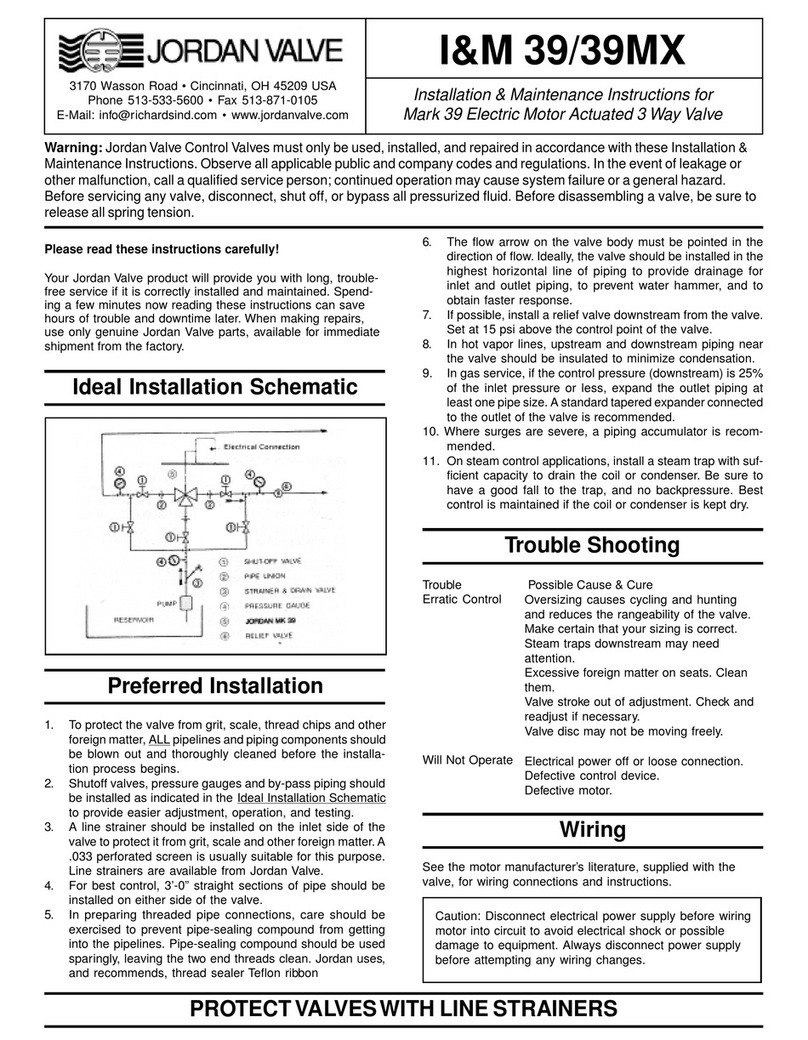
Jordan Valve
Jordan Valve Mark 39 Installation & maintenance instructions
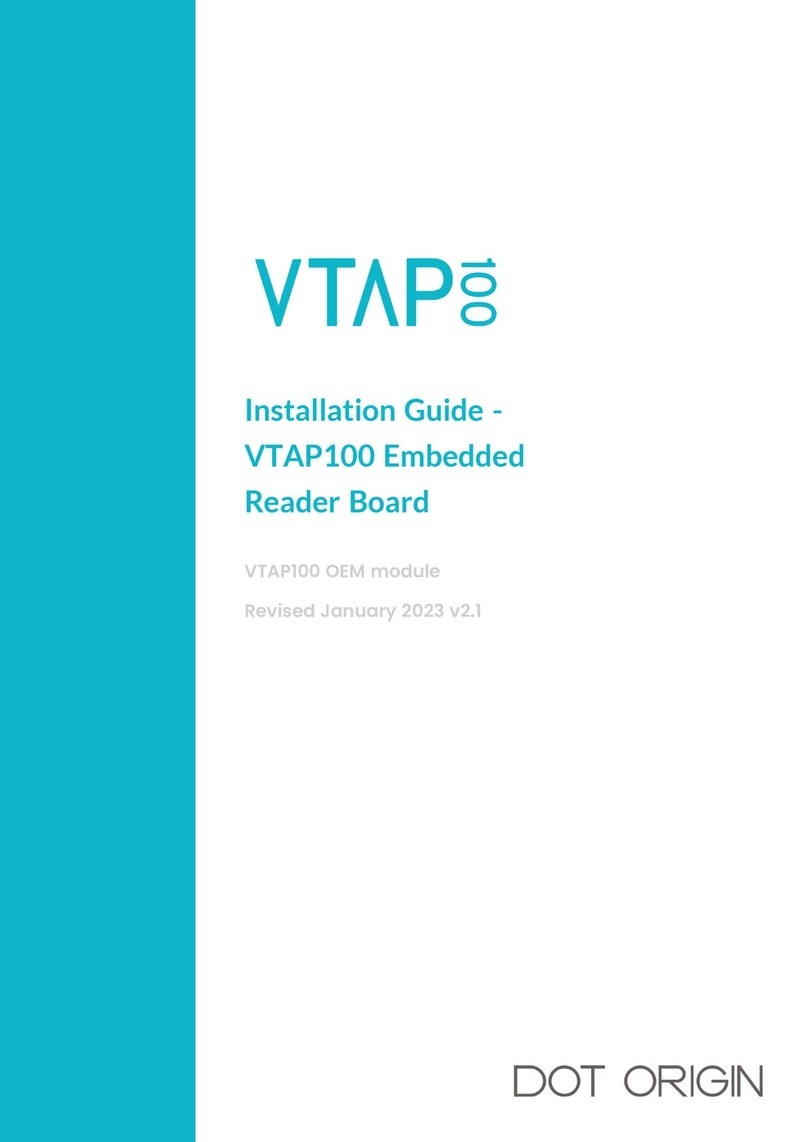
Dot Origin
Dot Origin VTAP100 installation guide
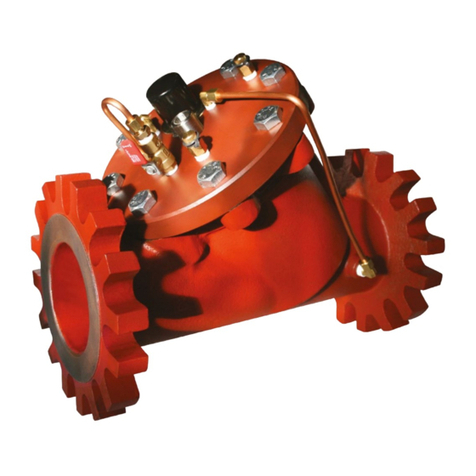
FlowCon
FlowCon PIM-DP quick start guide
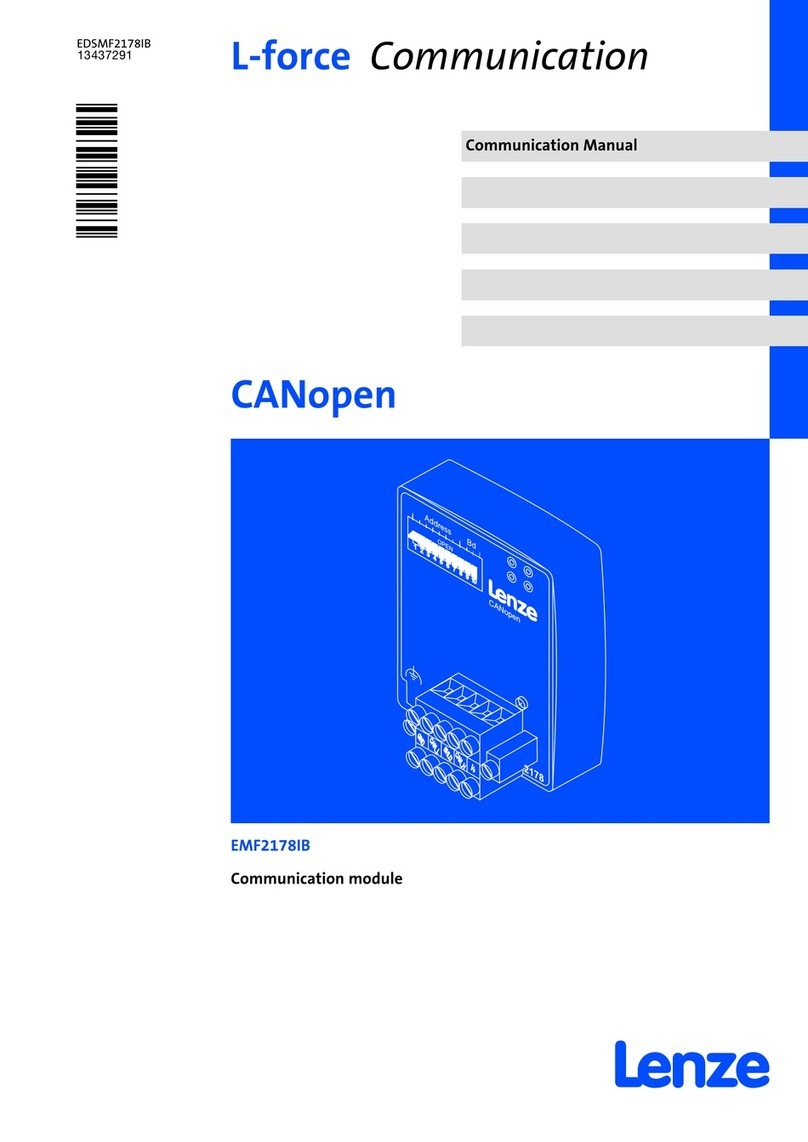
Lenze
Lenze L-force CANopen EMF2178IB Communications manual

Phoenix Contact
Phoenix Contact IBS IP 400 ME-ELR 2-3A FO datasheet
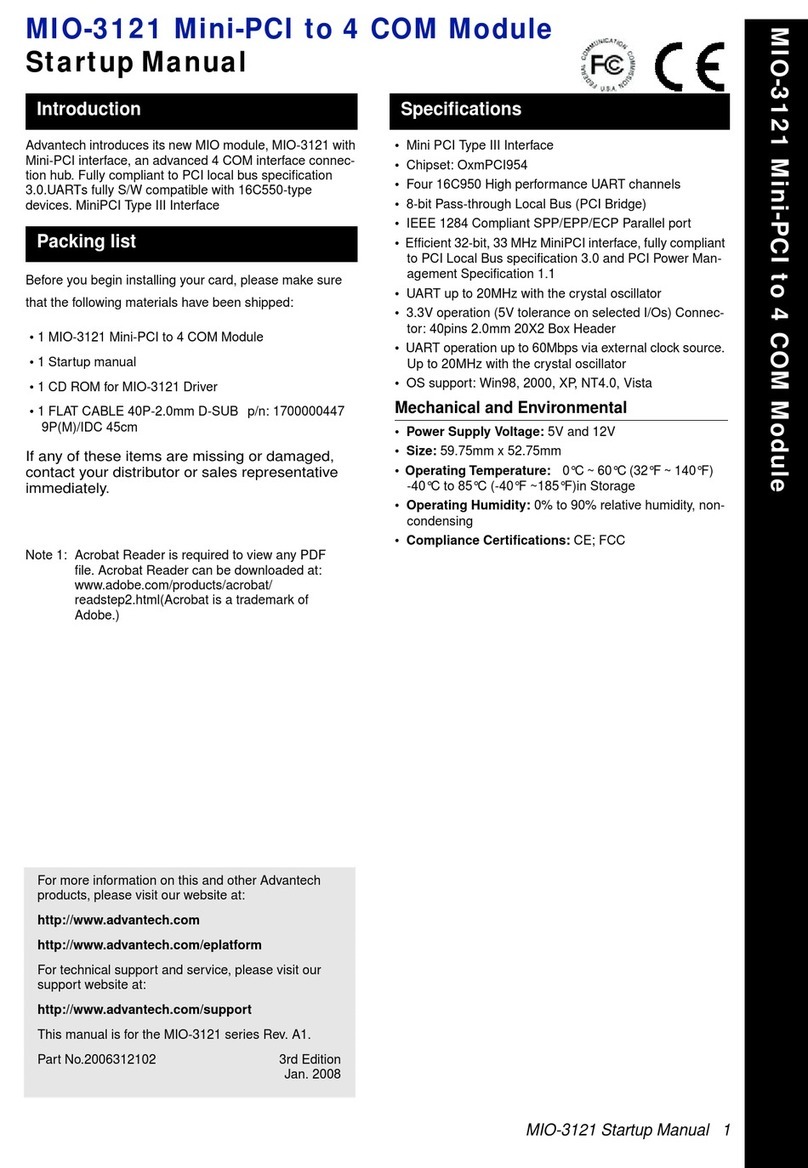
Advantech
Advantech MIO-3121 Startup manual
